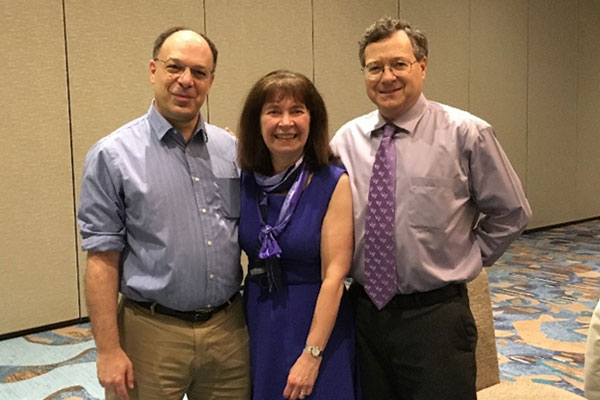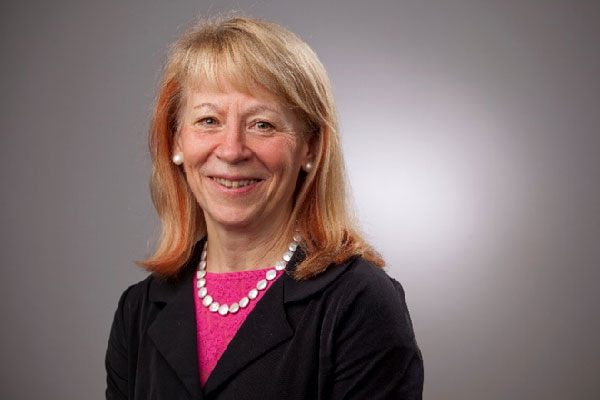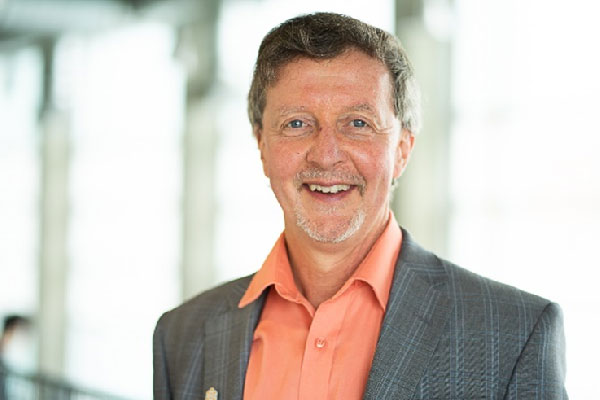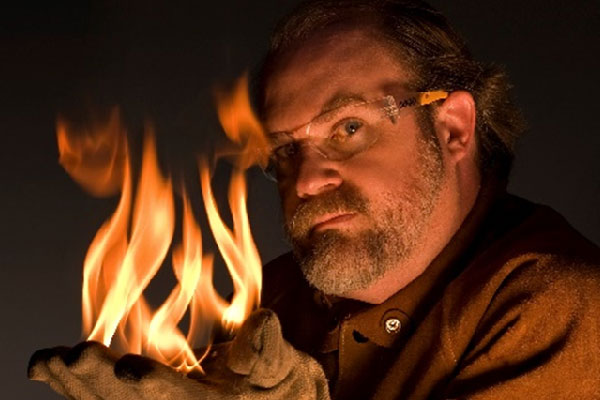Sunday, July 19 • 6PM - 6:50PM

Diane Bunce, US Naval Academy, Department of Chemistry, Annapolis, Maryland
Tom Greenbowe, University of Oregon, Department of Chemistry and Biochemistry, Eugene, Oregon
Rick Moog, Franklin and Marshall College, Department of Chemistry, Lancaster, Pennsylvania. Rick is serving as the facilitator for this session.
Diane, Tom and Rick are recipients of the American Chemical Society (ACS) Northeast Section James Flack Norris Award for Outstanding Achievement in the Teaching of Chemistry and the ACS George C. Pimentel Award for Chemical Education. In addition, they are Fellows of the American Chemical Society. The have served the ACS Division of Chemical Education in various capacities. They are committed to improving chemistry education through the implementation of active learning, using research and scholarship to assess teaching practices, and by helping chemistry educators collaborate.
Title: You Are Here At This Conference To Meet Chemistry Educators and Collaborate – We’re Going Help You Get Started
Abstract: This interactive presentation is designed to remind the participants of the BCCE with the main components of the field of chemistry education, some of the people involved in doing chemistry education, and how the Biennial Conference on Chemical Education works to support the goals of the ACS Division of Chemical Education. Brief introductions to some of the people who are serving or who have served in various capacities for the Journal of Chemical Education, the ACS DivCHED Examinations Institute, the American Association of Chemistry Teachers, the Biennial Conference Committee, the BCCE program committees, band members of Al D. Hyde and the Key Tones, and others will be made. An explanation of the ten themes of the 26th BCCE will be briefly presented: active learning pedagogies, technology & visualization, chemistry education research & scholarship, profession development, safety, chemistry content, assessment, diversity/equity/access, the use of social media in teaching chemistry, and chemistry laboratory experiments & chemistry demonstrations. Individuals from the audience will be asked to make brief presentations about how their workshop, paper, or poster fits in one or more of these themes. An explanation of the “stickers” corresponding to the themes of the conference will be offered. One purpose of the presentation is to help conference participants get to know some of the chemistry educators who are attending the conference and to open the doors for people to begin to collaborate on improving chemistry education.
Combined brief biographies of Diane and Tom as told from a semi-historical view and with an emphasis on the power of collaboration.
This is a story of two chemistry educators whose professional lives over the course of forty years have converged and diverged. Diane and Tom, along with many others, shared the goal of getting chemistry education research and scholarship recognized as a legitimate field of study within the American Chemical Society and within the International science education community. Diane and Tom also shared goals of promoting active learning, improving problem solving, assessing understanding of chemistry, and collaborating with colleagues.
Diane and Tom both earned their bachelor’s degrees at small colleges, Diane graduated from Le Moyne College, Syracuse, New York, while Tom graduated from William Paterson College Wayne, New Jersey. They both earned master’s degrees and then as luck would have it they both decided to enter the new field of chemistry education research. Diane earned her Ph.D. from the University of Maryland, College Park under the direction of two leading chemistry educators Henry Heikkinen and Marjorie Gardner. Tom earned his Ph.D. from Purdue University working under the direction of J. Dudley Herron, George Bodner, William Robinson, and Derek Davenport. At the time, there were only a few fledgling chemistry education doctoral programs in the USA, there were ten chemistry education doctoral students, and there were two openings for chemicals educators at colleges and universities. The published literature in Chemical Education was very limited. It included Henry’s linking mathematics skills to success in chemistry, Dudley’s link to student difficulties in understanding chemistry to Piaget’s Theory of Intelligence, George’s interpretation of Constructivism and how students learn, Bill’s explanation of the logical patterns in crystallography, and Derek’s exhortations about silver chloride being a pale green gas and elevating them guns a little lower. Much to our surprise, when we presented our dissertation research papers in the same symposium sessions at the 8th Biennial Conference on Chemical Education at the University of Connecticut, Storrs, CT and at a National Association of Research In Science Teaching (NARST) meeting in Boston we realized our research directors knew each other, they served on national committees together, they communicated with each other about collaboration on research projects. Diane and Tom came away with several impressions. First was that chemistry educators were not as respected on the as chemistry researchers – within chemistry departments and within the American Chemical Society. Second, if we did not begin to collaborate with our generation of chemistry educators, things would stay the same.
Over the next thirty years, Diane and Tom served the chemistry education community in many ways. Diane worked with John W. Moore (University of Wisconsin – Madison), on the NSF New Traditions projects. Tom served as an external evaluator of this project. Both Tom and Diane served on ACS DivCHED Examinations Institute committees. Diane worked with Dorothy Gabel (Indiana University) on student difficulties with conceptual understanding of chemistry and they published a book summarizing the science education research literature. Tom had an idea for a conceptual understanding general chemistry exam. Diane worked with Tom to secure external funding from ACS SOCED for this ACS exam committee. Diane was the Chair of the first ACS Conceptual General Chemistry Examination, William Robinson was the Chair of the third exam committee, and Tom was the co-chair for the sixth ACS Conceptual General Chemistry Examination along with Jamie Schneider (University of Wisconsin – River Falls). Tom served on the Advanced Placement (AP) Chemistry Test development committee with Jim Spencer (Franklin and Marshall College) and severed as Question Leader at the AP Chemistry Readings and as an AP Chemistry Consultant facilitating workshops for AP Chemistry teachers along with Marian DeWane (Centennial High School, Boise, ID and University of California – Los Angeles). In 2004, Tom served as the General Chair of the 18th Biennial Conference on Chemical Education hosted by Iowa State University and founded a classic rock and roll band “Al D. Hyde and the Key Tones” that has performed at all of the subsequent BCCEs. Diane and Tom both served as Chair of the ACS Division of Chemical Education. Diane served on ACS DivCHED Board of Publications; Tom served on the ACS DivCHED Board of Trustees. Diane is a co-author of two chapters in the famous two volume Chemist’s Guide to Effective Teaching edited by Tom, Norb Pienta (University of Georgia) and Melanie Cooper (Michigan State University). While Diane was the research section editor for the Journal of Chemical Education, Tom and his collaborators published several papers in JCE edited by Diane. Diane served as one of the external evaluators for the first two Process Oriented Guided Inquiry Learning (POGIL) NSF grants and worked with Jessica VandenPlas (Grand Valley State University) and Patrick Daubenmire (University of Loyola – Chicago). Tom worked with Rick Moog (Franklin and Marshall College), Frank Creegan (Washington College, Steve Gravelle (St. Vincent University) and Brandon Fetterly (University of Wisconsin – Richland) as POGIL/ Science Writing Heuristic (SWH) workshop facilitators and as a co-PI on an NSF project integrating POGIL with the Science Writing Heuristic along with Kathy Burke (Iowa State University).
Diane and Tom both conducted chemistry research with their respective graduate students. Diane focusing on how students learn chemistry, Tom on the use of computer simulations and animations (with John Gelder Oklahoma State University and Michael Abraham University of Oklahoma) and the Science Writing Heuristic with Brian Hand (University of Iowa). Diane and Tom both were invited speakers at a Gordon Research Conference: Chemical Education Research and Practice.
At a meeting of the DivCHED chemistry education research committee in 2006, Tom proposed that he would lead the charge to have the American Chemical Society recognize excellence in chemistry education research with an ACS award. At this meeting, Bill Robinson bet Tom he could not get his proposal approved by the ACS Awards committee. Diane immediately said that Tom would take that bet. After one year of constant work with the USA and International chemistry education research community, Tom submitted his proposal and the American Chemical Society approved the Award for Achievement in Research for the Teaching and Learning of Chemistry. In 2007, the first recipient of this award was J. Dudley Herron and in 2008 the second recipient of this award was Dorothy Gable. In 2019, Diane Bunce was the recipient of this award. The circle is now closed. Through the efforts of many chemistry educators collaborating over the past forty years, chemistry education research and scholarship is recognized as a legitimate field of research and scholarship.
Message to 26th BCCE Participants from Diane, Tom and Rick
Twenty years from now, you will have your story to tell. Your future depends on who you meet, when you meet them, and what you agree to do to help improve the teaching and learning of chemistry. The Biennial Conference on Chemical Education is one of the best conferences to meet individuals who share your goals and who want to work with you to improve education. One never knows when and where we will meet again or work together on various committees and projects. During the next three and a half days, let’s make the most of our time here at this conference.
Monday, July 20 • 11:15AM - 12:15PM

Geraldine Richmond, University of Oregon, Department of Chemistry and Biochemistry, Eugene, Oregon
Geraldine Richmond is a member of the U.S. National Academy of Sciences, the American Academy of Arts and Sciences and the U.S. National Science Board. She is the recipient of the 2018 Priestley Medal from the American Chemical Society, the Linus Pauling Medal Award (2018), and the National Medal of Science (2016). She is the founding director of COACh an organization that has helped over 20,000 women scientists and engineers in career advancement in the U.S. and many developing countries around the world.
Title: Surf, Sink or Swim: Understanding How Molecules Behave at Water Surfaces
Abstract: Water is the most precious substance on our planet. Environmental concerns about adequate clean water resources have increasingly become more global with the recognition that unwanted chemicals in the atmosphere, in our soils and in our surface waters often transport well beyond the national boundaries of origin. As a result, there is a growing international urgency to understand environmental issues that can cross boundaries with climate change, healthy air quality and clean water resources being the most obvious. This presentation will review the fundamental insights into molecular processes that underlie some of the science associated with water and discuss global concerns, with a particular focus on understanding the environmentally important impact water has for life on our planet. This presentation will also provide insights on how teachers can discuss water to students and to general audiences.
Brief Biography: Geraldine (Geri) Richmond is the Presidential Chair in Science and Professor of Chemistry at the University of Oregon. A native of Kansas, Richmond received her B.S. in Chemistry from Kansas State University in 1976 and her Ph.D. in physical chemistry under the direction of George Pimentel at the University of California, Berkeley in 1980. After her first faculty appointment as assistant professor at Bryn Mawr College she moved to the University of Oregon where she has been since 1985. Her research using nonlinear laser spectroscopy and computational methods focuses on understanding environmentally and technologically important processes that occur at liquid surfaces.
Tuesday, July 21 • 11:15AM - 12:15PM

Peter G. Mahaffy, The King’s University Chemistry Department and the King’s Centre for Visualization in Science, Edmonton, Alberta, Canada
Peter Mahaffy recently completed six years of service as chair of the International Union of Pure & Applied Chemistry’s (IUPAC) Committee on Chemistry Education (CCE), where he co-facilitated the process to obtain United Nations designation of 2011 as the International Year of Chemistry and served on the IYC-2011 Management Committee. He was a charter member of the International Council of Science (ICSU) \Committee on Freedom and Responsibility in the Conduct of Science and served on the temporary working group on education and outreach for the Organization for the Prohibition of Chemical Weapons (OPCW), which received the Nobel Peace Prize in 2013.
Title: Chemistry Education Today for Our 2050 World
Abstract: Our current first-year chemistry students will be mid-career professionals in 2050. What will the world they work and live in look like? Will they see chemistry as a truly central science that played a crucial role in addressing the challenges identified in the early part of the century, such as mitigation and adaptation strategies to address global climate change? Will participants in the 41st BCCE in 2050 look back and see that chemistry stepped forward to play a leading role in meeting the UN Sustainable Development goals by 2030? What can we do in 2020 as chemistry educators to help learners re-imagine the world of 2050, and use their knowledge of chemistry to contribute solutions?
One approach that shows promise in guiding students to see the relevance of their chemistry education for addressing multiple emerging global challenges such as sustainability, alternative energy, planetary boundaries, and the UN Sustainable Development Goals is systems thinking. A Systems Thinking in Chemistry Education (STICE) framework[i] has been developed by a global IUPAC project team with the goal of moving learners from fragmented knowledge of chemical reactions and processes toward a more holistic understanding of the field. In this talk we will discuss what systems thinking is, review progress to date in implementing the IUPAC STICE project, and suggest approaches that you can use to help students develop a deeper understanding of the molecular basis of sustainability[ii]. Next steps for the IUPAC STICE project will be discussed, including suggestions arising from contributions to a special issue of the Journal of Chemical Education on “Reimagining Chemistry Education: Systems Thinking and Green & Sustainable Chemistry[iii].”

i Mahaffy, P.G.; Krief, A.; Hopf, H.; Matlin, S. A. (2018) “Reorienting Chemistry Education through Systems Thinking,” Nature Reviews Chemistry, 2, 1-3.
ii Mahaffy, P.G.; Matlin, S.; Holme, T.A.; MacKellar, (2019) J. “Systems Thinking for Education about the Molecular Basis of Sustainability,” Nature Sustainability, in-press.
iii Mahaffy, P.G.; Brush, E.J.; Haack, J.A; Ho, F.M. (2018). “Journal of Chemical Education Call for Papers-Special Issue on Reimagining Chemistry Education: Systems Thinking, Green & Sustainable Chemistry,” Journal of Chemical Education, 95 (10), 1689-1691.
Brief Biography: Peter Mahaffy is Professor of Chemistry at the King’s University in Edmonton, Alberta, Canada and director of the King’s Centre for Visualization in Science (www.kcvs.ca), working with a talented interdisciplinary team of undergraduates to provide digital learning resources used by over 500,000 students, educators and the public from over 100 countries each year. His current research and professional work is at the interfaces of chemistry education, including systems thinking in chemistry education, the uses of interactive technological tools to facilitate the learning of science, sustainability/green chemistry, chemical safety and security, and the responsible uses of chemistry. He served on the American Chemical Society (ACS) presidential working group to help professional chemists communicate climate science to the public, and co-chairs the Province of Alberta’s Quality Assurance Agency for universities (Campus Alberta Quality Council). He has authored 50 peer-reviewed publications in science and science education.
Wednesday, July 22 • 11:15AM - 12:15PM

Theodore Gray, Wolfram Research, Champaign, Illinois
After amassing thousands of samples of elements, Theodore Gray assembled the elements into a four-legged physical table representing the Periodic Table. The finished table was awarded the 2011 ACS Grady Stack Award for Interpreting Chemistry for the Public, as well as the 2002 Ig Nobel Award for Chemistry. Gray's love of the periodic table would lead him to team up with photographer Nick Mann in creating "The Elements: A Visual Exploration of Every Known Atom in the Universe" and "The Elements Vault." Gray founded Touch Press together with Max Whitby, John Cromie and Stephen Wolfram. In 2013, Touch Press's "Disney Animated," was named the best i-Pad app worldwide by Apple Corporation. Throughout his career, Gray has been an advocate for a broader engagement between the scientific community and the public at large.
Title: Communicating Science to the Disinterest Public
Abstract: How can chemistry teachers do a better job with communicating the importance and beauty of science to our students and to the general public? Students first introduction to science is through textbooks and simple laboratory activities, however a teacher’s personal approach and attitude toward science plays an important role in motivating students to devote time and energy to study science. This presentation will introduce chemistry teachers to a variety of “out-of-the box” resources that will enable the students to grasp difficult chemistry concepts and principles.
Brief Biography: Theodore (Theo) Gray went to University of Illinois Laboratory School High School in the Champaign Urbana area. He later received a B.S. in chemistry from the University of Illinois in 1986. Later he attended the University of California at Berkeley for graduate school for theoretical chemistry, but left the program to work with Stephen Wolfram. The company which was created, Wolfram Research, then would publish the user interface for Mathematica.
For many years, Gray wrote a regular column for Popular Science entitled "Gray Matter." The column was a finalist for a National Magazine Award for Best Column in 2010. In 2009, a collection of articles by Gray was published under the title Mad Science: Experiments You Can Do at Home—But Probably Shouldn't. A sequel to the book, Mad Science 2: Experiments You Can Do at Home, But STILL Probably Shouldn't was published in 2013. In 2010, Gray founded Touch Press together with Max Whitby, John Cromie and Stephen Wolfram. The company was created to develop innovative educational apps using the technology of the iPad to its full potential. The first published app was "The Elements," and in 2014 Gray released "Molecules", which allows users to touch and discover the basic building blocks of the world. Of Touch Press's "Disney Animated," which was named the best iPad app of 2013 worldwide by Apple, iTunes's App Editor noted, "We’re absolutely spellbound.”